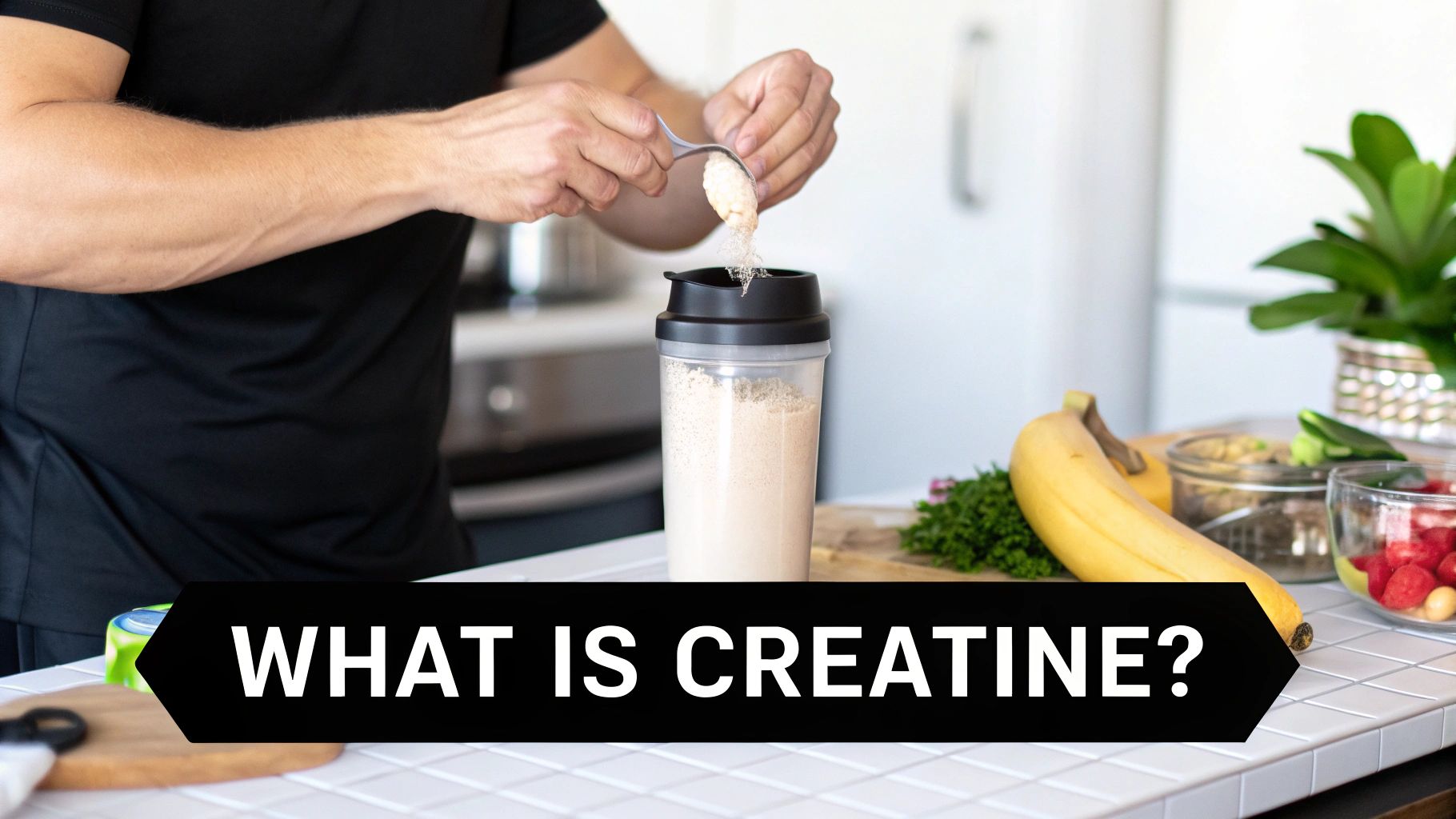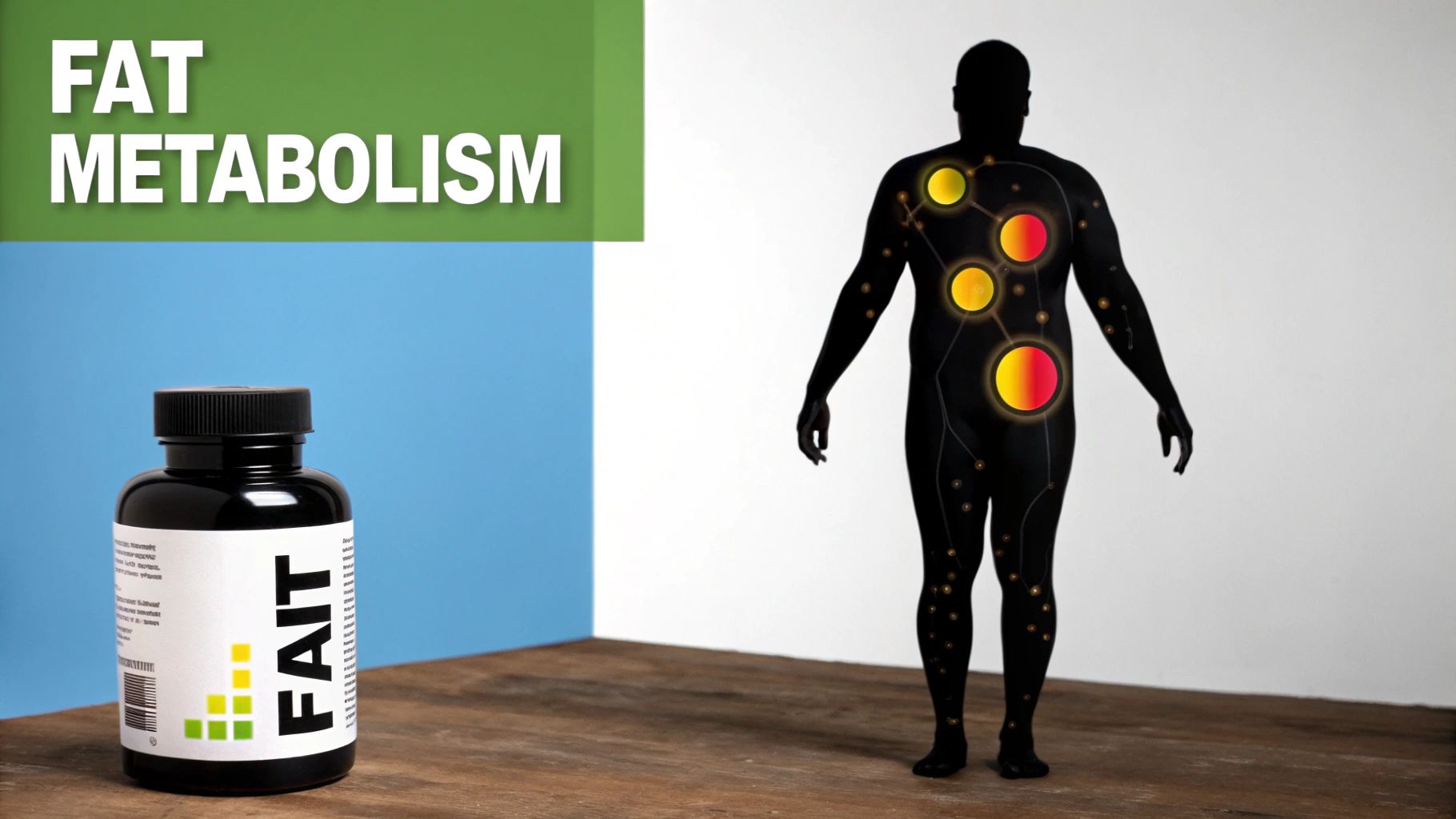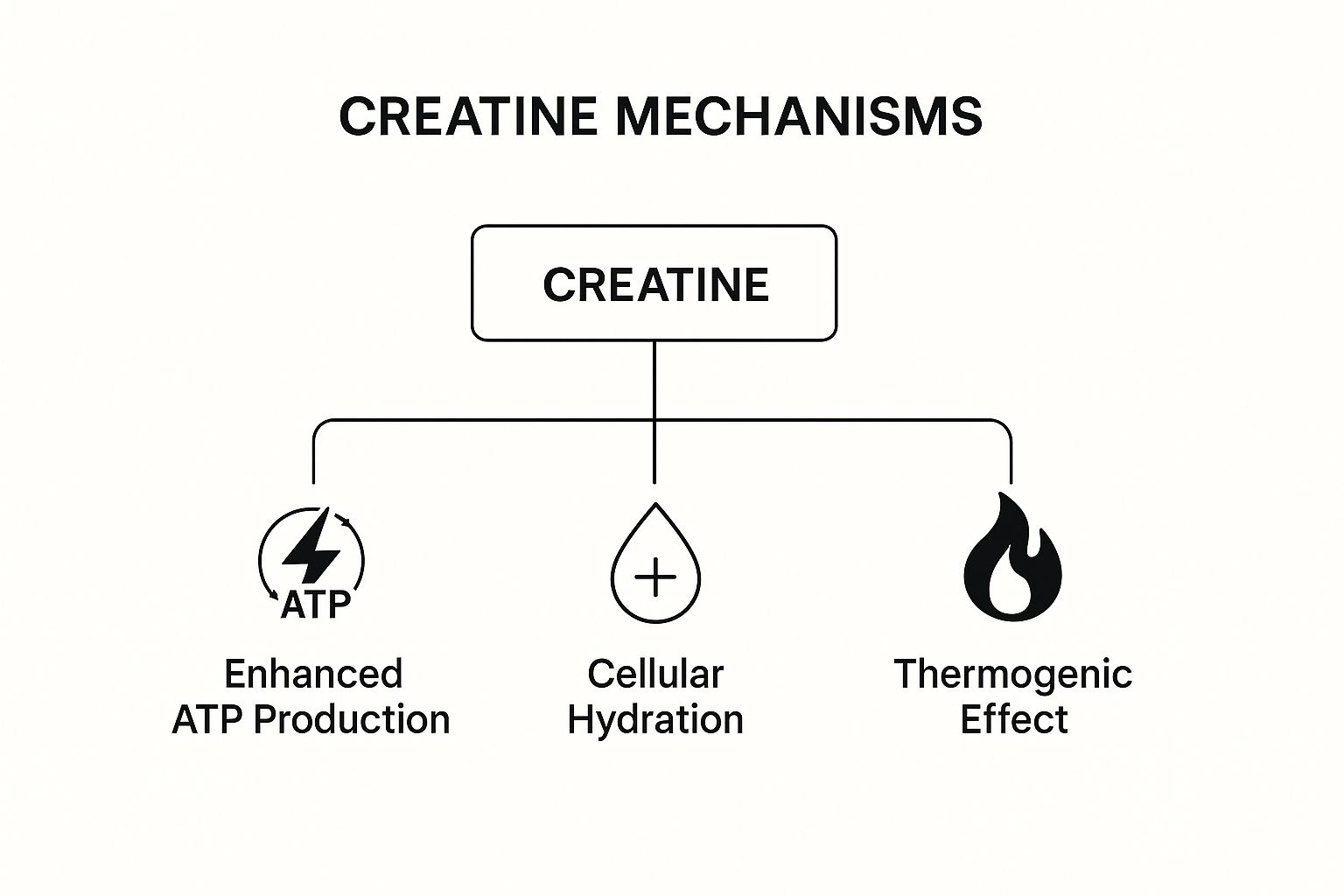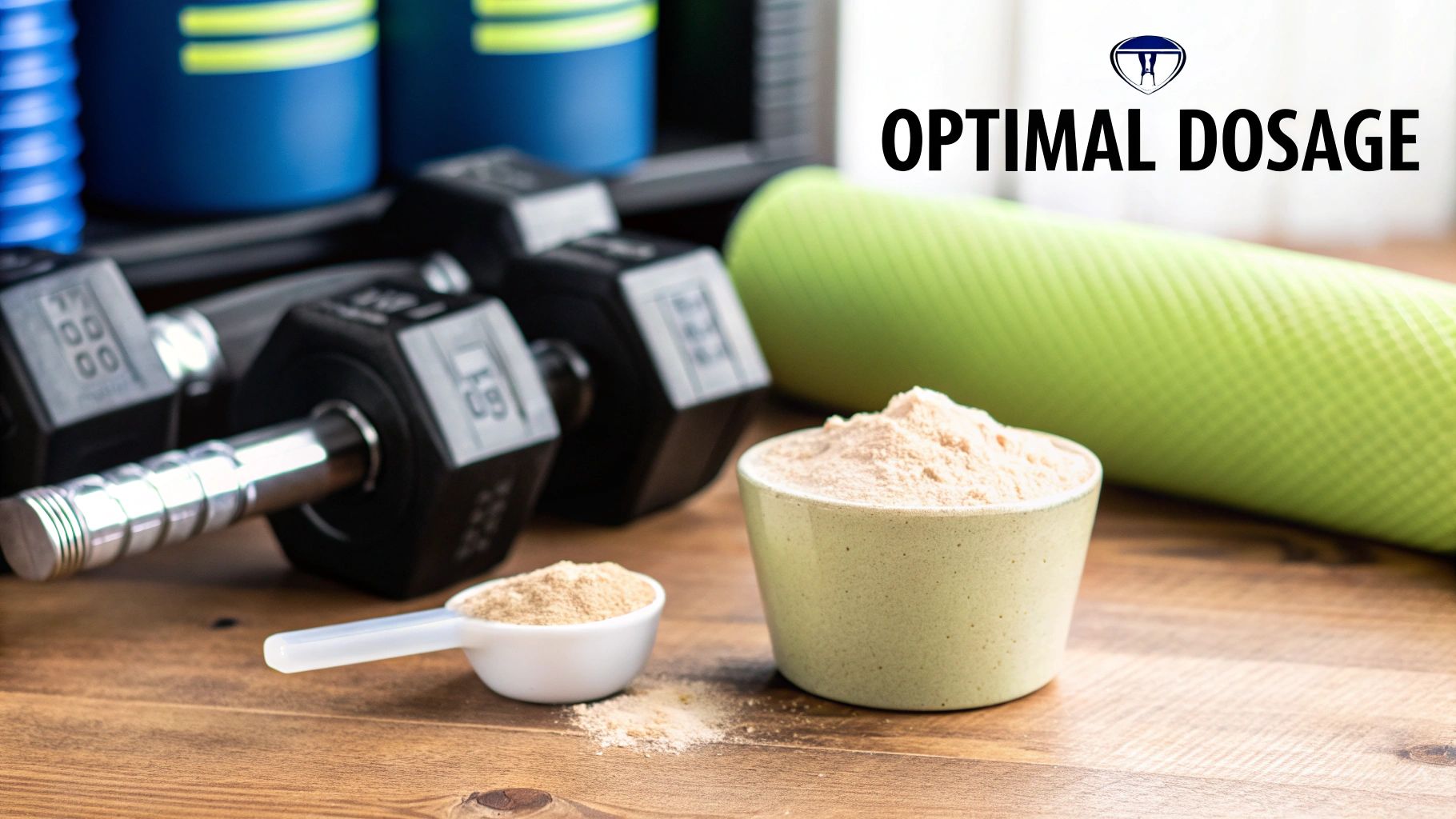
Can Creatine Help You Lose Fat? The Real Answer
Share
So, does creatine actually help you lose fat? Yes, but probably not in the way you're thinking.
Creatine isn’t some magic fat-burning pill that melts calories off your body. Its role is much smarter and more strategic. Think of it as a catalyst for your body's own fat-burning engine. Creatine helps you build lean muscle, and that muscle, in turn, revs up your metabolism, making you a more efficient fat-burning machine over the long haul.
The Surprising Link Between Creatine and Fat Loss

When most people think of creatine, their minds jump straight to massive muscle gains and explosive power—not shedding fat. The whole conversation gets bogged down in myths, especially the one about it causing you to gain the "wrong" kind of weight. But when you look at the science, a much more nuanced picture emerges.
Creatine doesn't work like a typical "fat burner." It's not a thermogenic, meaning it doesn't directly crank up your body temperature to torch calories. Instead, its genius lies in how it amplifies your efforts in the gym.
It acts as a high-performance fuel for your muscles, letting you push harder, lift heavier, and squeeze out those last few reps that really matter for growth. This boost in workout capacity is the first domino to fall in the chain reaction that leads to fat loss.
First Things First: What’s with the Initial Weight Gain?
Let's tackle the elephant in the room. One of the biggest freak-outs people have when starting creatine is seeing the number on the scale go up. It feels completely counterintuitive when your goal is to lose fat, but it's vital to understand what's happening under the hood.
This initial bump in weight isn't fat. It's just water. Creatine pulls water into your muscle cells, a process called cellular hydration.
Think of it as a good thing—it’s a clear sign the creatine is doing its job. Your muscles are getting hydrated and primed for better performance and growth. Many people even notice their muscles look fuller and more defined.
This hydration process is what sets the stage for the real benefits. By enabling more intense, productive workouts, creatine helps you build more metabolically active tissue—lean muscle. And that is the secret to sustainable fat loss.
Your Muscle Is a Metabolic Furnace
Here’s the bottom line: the more muscle you carry, the more calories your body burns, even when you're just sitting on the couch. This is your resting metabolic rate (RMR). By helping you pack on quality muscle, creatine indirectly transforms your body into a 24/7 calorie-burning powerhouse.
To see how creatine really changes your body, it helps to break down its effects.
Creatine's Real Impact on Your Body Composition
| Area of Impact | Direct Effect | Indirect Effect |
|---|---|---|
| Water | Increases water content inside muscle cells (cellular hydration). | Supports muscle repair and growth, which rely on proper hydration. |
| Muscle | Provides rapid energy (ATP) for more intense muscle contractions. | Enables harder workouts, leading to greater muscle protein synthesis and lean mass gains over time. |
| Fat | None. Creatine has zero direct impact on fat cells. | Boosts metabolism by increasing muscle mass; helps preserve muscle during a diet, ensuring you lose fat, not muscle. |
This table shows that while creatine won't directly attack fat, it strengthens the very systems responsible for burning it.
The benefits just keep stacking up from there:
- More Muscle Mass: Every pound of muscle you add directly increases your RMR.
- Better Body Composition: During a diet, creatine is a huge asset for helping you hold onto muscle, making sure the weight you lose is actually fat.
- Higher Workout Intensity: When you burn more energy during your workouts, you burn more calories per session.
So, while creatine won't make fat magically disappear, it's one of the most powerful allies you can have in your mission to build a stronger, leaner body. It’s the ultimate support crew for your fat-loss goals.
How Creatine Fuels Your Muscles for Better Workouts

To really get how creatine ties into fat loss, we first have to talk about its day job: being an absolute powerhouse for your muscles. Creatine doesn't directly torch fat cells. Instead, it supercharges the very thing that does lead to fat loss—a killer workout.
Think of your muscles as having tiny, rechargeable batteries. These batteries run on a high-octane molecule called adenosine triphosphate (ATP). This is the go-to energy source for anything explosive, from a heavy deadlift to a full-out sprint.
The problem is, when you go hard during a set of squats, your muscles burn through their ATP supply in just a few seconds. This is precisely where creatine steps in, acting like a super-fast charging dock for those drained batteries.
The ATP-Creatine Energy Cycle
Your body stores most of its creatine inside your muscles as something called phosphocreatine. When ATP is used for energy, it loses a phosphate molecule and becomes adenosine diphosphate (ADP)—basically, a "dead" battery that's no longer useful.
This is the magic moment. Phosphocreatine swoops in and gives its phosphate to that useless ADP molecule, instantly recycling it back into a fully charged ATP molecule. This whole process happens in a flash, giving your muscles the immediate juice needed to grind out that extra rep or two you couldn't hit before.
This isn’t just a small bump in performance. It’s the difference between a workout that maintains and one that builds. Those last, tough reps are what force your body to get stronger.
By keeping your muscles stocked with creatine, you’re making sure this rapid-recharge system is always primed and ready. You’ll be able to sustain a higher intensity for your entire workout, not just the first couple of sets.
Translating Power into Progress
So, what does all this supercharged energy mean for your body composition? It means every single trip to the gym becomes more productive.
- Increased Strength and Power: Time and again, studies show creatine supplementation gives a real, measurable boost to your strength, helping you move more weight.
- Enhanced Muscular Endurance: You can simply do more work before your muscles tap out and fatigue sets in.
- Improved Anaerobic Capacity: Your ability to crush high-intensity workouts, like HIIT or CrossFit, gets a serious upgrade.
This enhanced capacity in the gym is the first critical domino to fall. By helping you train harder and more effectively, creatine lays the groundwork for building lean muscle. To really dive into that connection, check out our guide on creatine for muscle growth. The bottom line is simple: a better workout today means more muscle tomorrow, and that’s the secret to cranking up your metabolism and shedding body fat.
Unlocking Fat Loss Through Muscle and Metabolism
So, supercharged workouts are great, but how does that actually help you get leaner? The connection is more straightforward than you might think. Building lean muscle is the real secret to sustainable, long-term fat loss, and creatine is the key that unlocks the whole process.
While creatine doesn't directly burn fat, it powerfully supports fat loss by upgrading your body's metabolic engine. It’s not a magic pill, but a catalyst.
This happens in a few ways that all work together. First, more muscle naturally boosts the number of calories you burn just by being alive. Second, the more intense workouts you can do will torch more calories every time you're in the gym. And finally, this whole cycle promotes better overall metabolic health, making your body far more efficient at managing energy.
It’s a simple but powerful formula: creatine fuels better workouts, and better workouts build more muscle. That new muscle then works for you 24/7, firing up your metabolism and helping you burn more fat.
Revving Up Your Metabolic Engine
Think of every pound of muscle on your body as a tiny, active furnace. It's always on, burning calories just to exist. This is your resting metabolic rate (RMR), and it’s responsible for most of the calories you burn each day. The more muscle you have, the hotter that collective furnace burns.
When creatine lets you lift heavier and push for that extra rep, you’re stimulating more muscle growth. Even a few new pounds of lean muscle can give your RMR a noticeable bump, which means you burn more calories while you’re at your desk, relaxing on the couch, and even while you sleep. That subtle but constant calorie burn is a total game-changer for fat loss.
Increasing Your Total Daily Energy Burn
Beyond just your resting metabolism, creatine also helps increase your total daily energy expenditure (TDEE). Your TDEE is the grand total of every calorie you burn in a 24-hour period, including your workouts. Since creatine allows for higher-intensity and higher-volume training, your sessions become a lot more demanding.
You’re not just lifting heavier; you're performing more total work. This increased output demands more energy, leading to a much higher calorie burn both during and after your workout. This post-exercise calorie burn—often called EPOC or the "afterburn effect"—gets a serious boost when your training sessions are more intense.
This graphic breaks down exactly how creatine gets the job done.

By boosting energy production and hydrating your muscle cells, creatine creates the perfect environment for a more efficient, fat-burning metabolism.
The Proof Is in the Science
This isn't just a gym theory; solid science backs up creatine's role in improving body composition. While it may not be a direct fat-burner, its muscle-building effects create an environment where fat loss becomes much easier to achieve.
For instance, a major meta-analysis looked at adults over 50 who paired resistance training with creatine. The results were clear: the creatine group saw a significantly greater drop in body fat percentage—about 0.55% more—compared to the group that only did the training. This really shows how creatine can amplify the body-recomposition effects of your hard work. You can dive deeper into the full research on creatine and body composition to see the data for yourself.
Ultimately, creatine shifts the goal from just "losing weight" to improving your body composition. It helps you make sure the pounds you’re shedding are from fat, not from your precious, metabolism-boosting muscle.
By preserving and building lean mass, especially when you’re in a calorie deficit, creatine helps you sculpt a stronger, more defined physique instead of just becoming a smaller version of yourself. It’s a strategic tool for changing how your body looks and feels, not just the number on the scale.
Why the Scale Goes Up Before the Fat Comes Down

Let's get right to it and tackle the biggest worry most people have. You start taking creatine, step on the scale a few days later, and the number is up. When your goal is fat loss, that moment can feel like a total gut punch.
But here’s what’s really going on: that initial increase isn't fat. Not even a little bit. Creatine’s job is to pull water directly into your muscle cells, a process called intracellular water retention. Think of it as super-hydrating your muscles from the inside out. This is a very good thing. It’s a sign the creatine is working, priming your muscles for better performance and growth.
This is a world away from the puffy, uncomfortable feeling you get from subcutaneous bloat—the kind of water retention you might get under your skin after a particularly salty meal. The water weight from creatine is functional; it's inside the muscle, working for you.
Differentiating Good Weight from Bad Weight
I get it, seeing the scale move in the "wrong" direction is mentally tough. But this is where you need to shift your perspective. That number is just one piece of the puzzle, and in the early days of taking creatine, it’s a notoriously misleading one.
So, instead of getting hung up on your total body weight, start tracking metrics that actually tell you what's happening with your body composition.
- Look in the mirror. Are your muscles starting to look fuller or more defined? That’s the creatine at work.
- Track your workouts. Can you lift a little heavier? Squeeze out one more rep? That’s a clear sign of progress.
- Pay attention to your clothes. You might notice your pants getting looser around the waist even if the scale hasn’t budged. That’s a classic sign you’re losing fat and gaining muscle.
The initial water retention from creatine is just a temporary phase. It’s the starting pistol for real, positive changes. Trust the process and focus on how you look, feel, and perform.
The old myth that creatine makes you fat or bloated just doesn't hold up to scrutiny. A huge 2023 meta-analysis looked at all the evidence and confirmed that creatine supplementation does not promote fat accumulation. What it does do is help you build the lean muscle that torches fat in the long run.
For a deeper dive into this initial phase, check out our guide on how much weight gain to expect from creatine. Understanding the science will give you the confidence to push through that first week and see the real results you're after.
A Practical Guide to Using Creatine for Fat Loss
So, we've covered the science. Now, how do you actually use creatine to help you drop fat and build a leaner physique? The great news is that it’s refreshingly simple. You can ditch any complex timing or cycling protocols you might have heard about.
When it comes to creatine, consistency is everything. It’s not a stimulant you take for an immediate pre-workout buzz. Instead, its real power comes from keeping your muscle cells fully saturated over the long haul. A steady, daily dose ensures your muscles are always primed with the energy they need to work harder and recover better, every single day.
Nailing the Right Dose for Real Results
For almost everyone, the sweet spot is 3-5 grams of creatine monohydrate per day. This is the dose that’s been backed by study after study to effectively fill up your muscle stores and keep them topped off for sustained benefits.
You might hear people talk about a "loading phase," which involves taking a much larger dose—around 20 grams a day—for the first week to saturate your muscles faster. While this can get you there a couple of weeks sooner, it's totally optional. For many, it's not worth the risk of potential stomach upset. A simple 3-5 gram daily dose will get you to the exact same point of full saturation, just a bit more gradually and without any fuss.
If you want to dive deeper into the nuances of dosing, our complete creatine dosage guide from beginner to expert results breaks it all down.
The Real Secret Weapon
Here’s the part that often gets overlooked: creatine works when you do. It’s an incredible performance tool, but it can’t build a better body on its own. To really see its fat-loss benefits, you have to give it something to work with.
That means focusing on two non-negotiables:
- Consistent Strength Training: You have to put that extra energy to good use. Regular resistance training is what signals your body to build and maintain muscle, which is the core of how creatine improves your body composition.
- A Smart Nutrition Plan: A calorie deficit is the foundation of all fat loss. Creatine is fantastic for helping you hold onto precious muscle while you're in that deficit, but it can't defy the laws of energy balance.
While creatine is a huge asset, your results will ultimately be driven by what you eat. To make sure your efforts pay off, it's worth learning how to build a healthy meal plan for weight loss that fuels your training and supports your goals.
Think of creatine as an amplifier, not a magic pill. It takes the hard work you're already putting in at the gym and in the kitchen and turns up the volume, helping you see better, more significant results from your efforts.
Making Consistency a No-Brainer
Let's be honest, the biggest challenge isn't knowing what to do—it's sticking with it day after day. Fiddling with messy powders and shakers can be a real pain, especially when you're rushing out the door or traveling. This is where a little convenience can make all the difference.
This is exactly why options like Smash.com's creatine gummies are so popular. They take the guesswork and hassle out of the equation, delivering a precise 5-gram dose in a simple, tasty form. No measuring, no mixing, no chalky aftertaste. Just an easy, even enjoyable, way to get your creatine in.
When your daily supplement routine becomes a treat instead of a chore, you're far more likely to stick with it long enough to see the lean, strong results you're after.
Common Questions About Creatine and Fat Loss
Stepping into the world of supplements can feel like navigating a minefield, especially when you’re trying to shed some fat. Creatine, in particular, is surrounded by a cloud of questions and myths. Let's clear the air and tackle the biggest concerns people have when using it to get leaner.
When you have clear, science-backed answers, you can use supplements with confidence. That way, you can put your energy into your workouts and diet, knowing your creatine is helping, not hurting, your progress.
Will Creatine Make Me Look Bloated or Puffy?
This is probably the number one myth that scares people away from creatine. Here’s the deal: the water retention from creatine is intracellular. That’s a fancy way of saying the water is pulled inside your muscle cells, not under your skin.
This process is actually a good thing. It makes your muscles look fuller, harder, and more defined. It’s the complete opposite of that soft, puffy look you might get from eating too much salty food. If you notice your muscles looking a bit more "pumped," that's a sign the creatine is doing its job perfectly.
Think of creatine "bloat" as functional water weight that contributes to a stronger, more athletic look—not the kind of bloating that makes you feel soft and puffy.
Should I Take Creatine While Cutting?
Absolutely. In fact, a cutting phase is one of the best times to be using creatine. When you’re eating in a calorie deficit to lose fat, you’re always at risk of losing some hard-earned muscle along with it.
Creatine helps you keep your strength and intensity up in the gym, even on lower calories. This signals to your body that it needs to hold onto that metabolically active muscle tissue. By preserving muscle, you ensure that the pounds you're shedding are coming from fat stores, which is exactly what you want.
Can I Lose Fat with Creatine but Without Exercise?
That’s going to be a hard no. Creatine has zero magical fat-burning properties on its own. Its benefits are entirely tied to how it improves your performance during a workout.
Think of it like high-octane fuel for a car that’s sitting in the garage. The fuel is useless until you turn the key and drive. Creatine gives you the extra energy to push harder and lift heavier, and that’s what builds the muscle that revs up your metabolism. Without the exercise part of the equation, you simply won't see results.
Are Creatine Gummies as Effective as Powder for Fat Loss?
Yep, they sure are. The form it comes in doesn’t change the science. Your body doesn’t know the difference between creatine monohydrate from a chalky powder or a delicious gummy. As long as you hit that sweet spot of 3-5 grams per day, your muscles will get saturated and you’ll see the same performance benefits.
At the end of the day, the best type of creatine is the one you actually take consistently. For a lot of us, the convenience and taste of a gummy make it way easier to stick with the habit. Better consistency almost always leads to better results.
Ready to make consistency your new superpower? Smash.com creatine gummies deliver the full 5-gram dose of pure creatine monohydrate in a delicious, convenient form. Ditch the messy powders and take the guesswork out of your routine. Visit https://smash.com to fuel your goals and start seeing the results of your hard work.